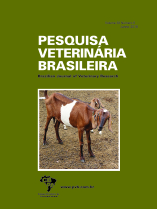 |
|
|
|
Year 2018 - Volume 38, Number 6
|

|
Radiographic assessment of the proximal tibial angles in dogs and cats with and without cranial cruciate ligament rupture, 38(6):1190-1195
|
ABSTRACT.- Arruda A.F.D.P., Muzzi L.A.L., Lacreta Junior A.C.C., Muzzi R.A.L., Sampaio G.R., Moreira S.H. & Mesquita L.R. 2018. Radiographic assessment of the proximal tibial angles in dogs and cats with and without cranial cruciate ligament rupture. [Avaliação radiográfica dos ângulos da tibia proximal em cães e gatos com e sem ruptura do ligamento cruzado cranial.] Pesquisa Veterinária Brasileira 38(6):1190-1195. Departamento de Medicina Veterinária, Universidade Federal de Lavras, Av. Doutor Sylvio Menicucci 1001, Cx. Postal 3037, Kennedy, Lavras, MG 37200-000, Brazil. E-mail: lalmuzzi@dmv.ufla.br
The influence of the proximal tibial angles in the cranial cruciate ligament (CCL) rupture in dogs is still controversial, and little is known regarding this topic in cats. The aim of this study was to evaluate and compare the angles of the proximal portion of the tibia in dogs and cats with and without CCL rupture. Retrospective and prospective radiographs of the stifle joints were obtained and divided into four groups. Group 1 was composed of 70 stifle joint images of dogs without orthopedic disorders (healthy dogs), group 2 had 70 stifle joint images of dogs with CCL rupture, group 3 had 50 stifle joint images of cats without orthopedic disorders (healthy cats) and group 4 had 25 stifle joint images of cats with CCL rupture. Radiographs were taken with the stifle joint in the mediolateral projection, positioned at the angle of hind limb support. Between the two groups of dogs evaluated, the dogs with CCL rupture had statistically greater tibial plateau angle (TPA) compared with healthy dogs. No difference was shown in relation to the TPA between healthy cats and cats with CCL rupture. In relation to the patellar ligament angle by tibial plateau method the values for the healthy dogs were significantly higher than those for the CCL ruptured dogs. Similarly, healthy cats had significantly higher mean values than cats with CCL rupture. In the patellar ligament angle by common tangent method there was no significantly difference between the two groups of dogs. Between the two groups of cats, animals with CCL rupture had statistically higher mean values than healthy cats. In general, the groups of dogs showed higher mean values than the groups of cats. For the patellar ligament insertion angle (PLIA) healthy dogs showed a significantly higher mean than dogs with CCL rupture. There was no significant difference between the groups of cats. In conclusion, the TPA and the PLIA possibly influence the etiology of CCL rupture in dogs but not in cats. The low patellar ligament angle measured by common tangent method may favorably influence the reduced incidence of CCL rupture in cats. |
| |
|
|
| |
|
 |